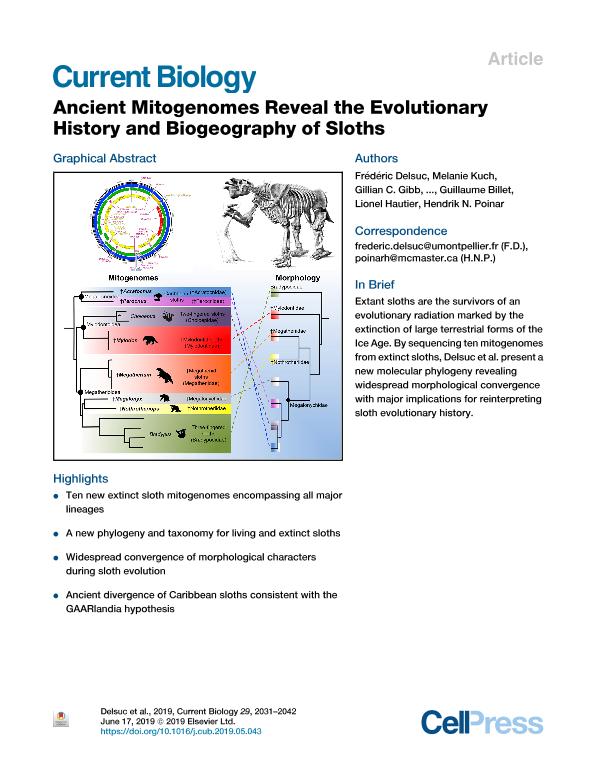Mostrar el registro sencillo del ítem
dc.contributor.author
Delsuc, Frédéric
dc.contributor.author
Kuch, Melanie
dc.contributor.author
Gibb, Gillian C.
dc.contributor.author
Karpinski, Emil
dc.contributor.author
Hackenberger, Dirk
dc.contributor.author
Szpak, Paul
dc.contributor.author
Martinez, Jorge Gabriel

dc.contributor.author
Mead, Jim I.
dc.contributor.author
McDonald, H. Gregory
dc.contributor.author
Macphee, Ross Douglas Earle

dc.contributor.author
Billet, Guillaume
dc.contributor.author
Hautier, Lionel
dc.contributor.author
Poinar, Hendrik N.
dc.date.available
2021-07-26T13:44:28Z
dc.date.issued
2019-06
dc.identifier.citation
Delsuc, Frédéric; Kuch, Melanie; Gibb, Gillian C.; Karpinski, Emil; Hackenberger, Dirk; et al.; Ancient Mitogenomes Reveal the Evolutionary History and Biogeography of Sloths; Cell Press; Current Biology; 29; 12; 6-2019; 2031-2042.e6
dc.identifier.issn
0960-9822
dc.identifier.uri
http://hdl.handle.net/11336/136908
dc.description.abstract
Living sloths represent two distinct lineages of small-sized mammals that independently evolved arboreality from terrestrial ancestors. The six extant species are the survivors of an evolutionary radiation marked by the extinction of large terrestrial forms at the end of the Quaternary. Until now, sloth evolutionary history has mainly been reconstructed from phylogenetic analyses of morphological characters. Here, we used ancient DNA methods to successfully sequence 10 extinct sloth mitogenomes encompassing all major lineages. This includes the iconic continental ground sloths Megatherium, Megalonyx, Mylodon, and Nothrotheriops and the smaller endemic Caribbean sloths Parocnus and Acratocnus. Phylogenetic analyses identify eight distinct lineages grouped in three well-supported clades, whose interrelationships are markedly incongruent with the currently accepted morphological topology. We show that recently extinct Caribbean sloths have a single origin but comprise two highly divergent lineages that are not directly related to living two-fingered sloths, which instead group with Mylodon. Moreover, living three-fingered sloths do not represent the sister group to all other sloths but are nested within a clade of extinct ground sloths including Megatherium, Megalonyx, and Nothrotheriops. Molecular dating also reveals that the eight newly recognized sloth families all originated between 36 and 28 million years ago (mya). The early divergence of recently extinct Caribbean sloths around 35 mya is consistent with the debated GAARlandia hypothesis postulating the existence at that time of a biogeographic connection between northern South America and the Greater Antilles. This new molecular phylogeny has major implications for reinterpreting sloth morphological evolution, biogeography, and diversification history. Extant sloths are the survivors of an evolutionary radiation marked by the extinction of large terrestrial forms of the Ice Age. By sequencing ten mitogenomes from extinct sloths, Delsuc et al. present a new molecular phylogeny revealing widespread morphological convergence with major implications for reinterpreting sloth evolutionary history.
dc.format
application/pdf
dc.language.iso
eng
dc.publisher
Cell Press

dc.rights
info:eu-repo/semantics/openAccess
dc.rights.uri
https://creativecommons.org/licenses/by-nc-sa/2.5/ar/
dc.subject
ANCIENT DNA
dc.subject
BIOGEOGRAPHY
dc.subject
CONVERGENCE
dc.subject
EXTINCT SLOTHS
dc.subject
GAARLANDIA
dc.subject
MITOGENOMICS
dc.subject
MOLECULAR DATING
dc.subject
MORPHOLOGY
dc.subject
PHYLOGENETICS
dc.subject.classification
Biología

dc.subject.classification
Ciencias Biológicas

dc.subject.classification
CIENCIAS NATURALES Y EXACTAS

dc.title
Ancient Mitogenomes Reveal the Evolutionary History and Biogeography of Sloths
dc.type
info:eu-repo/semantics/article
dc.type
info:ar-repo/semantics/artículo
dc.type
info:eu-repo/semantics/publishedVersion
dc.date.updated
2020-11-20T18:04:16Z
dc.journal.volume
29
dc.journal.number
12
dc.journal.pagination
2031-2042.e6
dc.journal.pais
Estados Unidos

dc.journal.ciudad
United States
dc.description.fil
Fil: Delsuc, Frédéric. Université Montpellier II; Francia
dc.description.fil
Fil: Kuch, Melanie. Mcmaster Ancient Dna Centre; Canadá
dc.description.fil
Fil: Gibb, Gillian C.. Massey University; Nueva Zelanda. Université Montpellier II; Francia
dc.description.fil
Fil: Karpinski, Emil. Mcmaster Ancient Dna Centre; Canadá. Mcmaster University; Canadá
dc.description.fil
Fil: Hackenberger, Dirk. Mcmaster Ancient Dna Centre; Canadá
dc.description.fil
Fil: Szpak, Paul. Trent University; Canadá
dc.description.fil
Fil: Martinez, Jorge Gabriel. Universidad Nacional de Tucumán; Argentina. Consejo Nacional de Investigaciones Científicas y Técnicas. Centro Científico Tecnológico Conicet - Tucumán. Instituto Superior de Estudios Sociales. Universidad Nacional de Tucumán. Instituto Superior de Estudios Sociales; Argentina
dc.description.fil
Fil: Mead, Jim I.. East Tennessee State University; Estados Unidos
dc.description.fil
Fil: McDonald, H. Gregory. Bureau of Land Management; Estados Unidos
dc.description.fil
Fil: Macphee, Ross Douglas Earle. American Museum of Natural History; Estados Unidos
dc.description.fil
Fil: Billet, Guillaume. Université Pierre et Marie Curie; Francia
dc.description.fil
Fil: Hautier, Lionel. Natural History Museum; Reino Unido. Université Montpellier II; Francia
dc.description.fil
Fil: Poinar, Hendrik N.. Mcmaster Ancient Dna Centre; Canadá
dc.journal.title
Current Biology

dc.relation.alternativeid
info:eu-repo/semantics/altIdentifier/url/https://www.cell.com/current-biology/fulltext/S0960-9822(19)30613-X?_returnURL=https%3A%2F%2Flinkinghub.elsevier.com%2Fretrieve%2Fpii%2FS096098221930613X%3Fshowall%3Dtrue
dc.relation.alternativeid
info:eu-repo/semantics/altIdentifier/doi/http://dx.doi.org/10.1016/j.cub.2019.05.043
Archivos asociados
